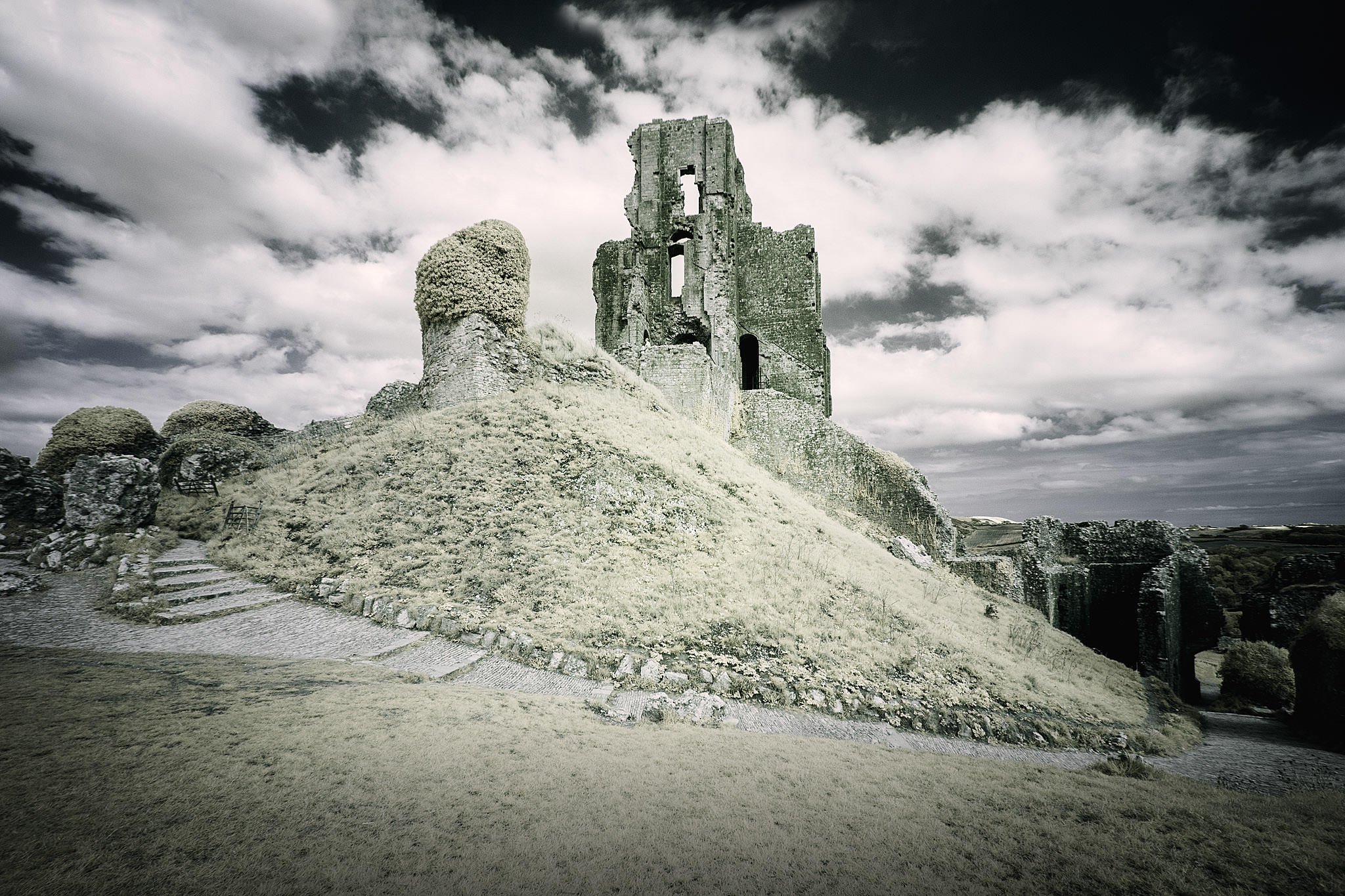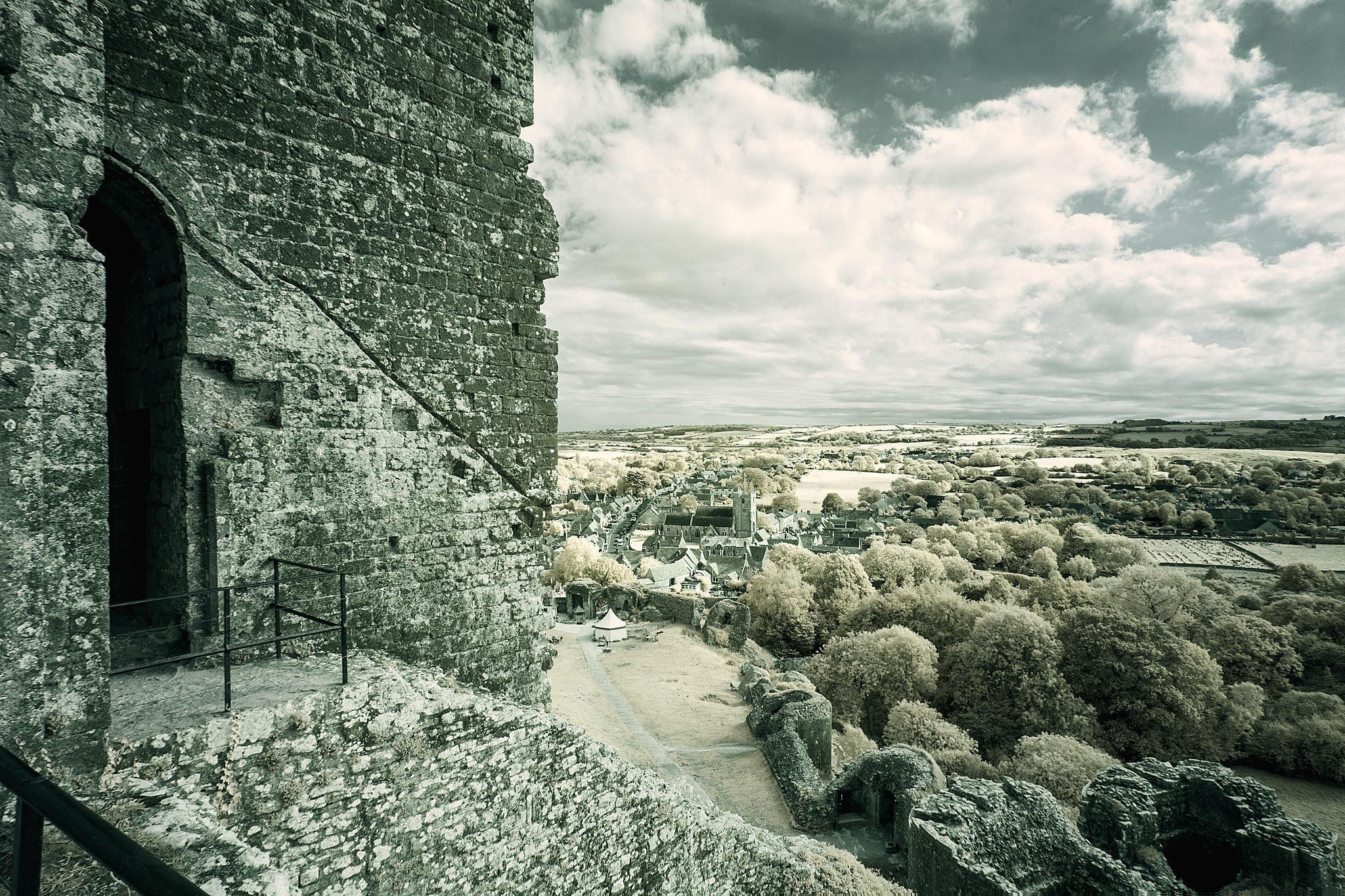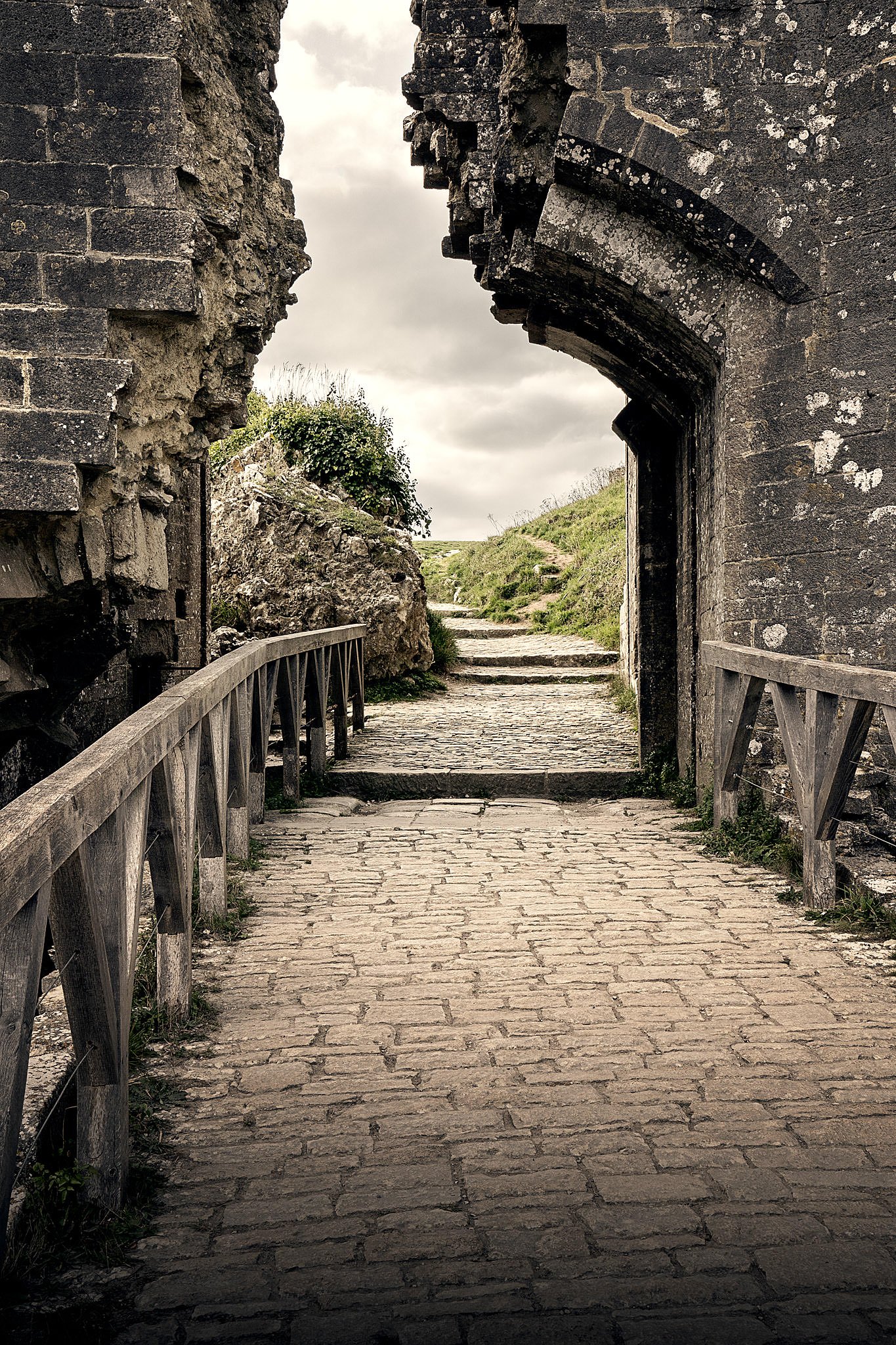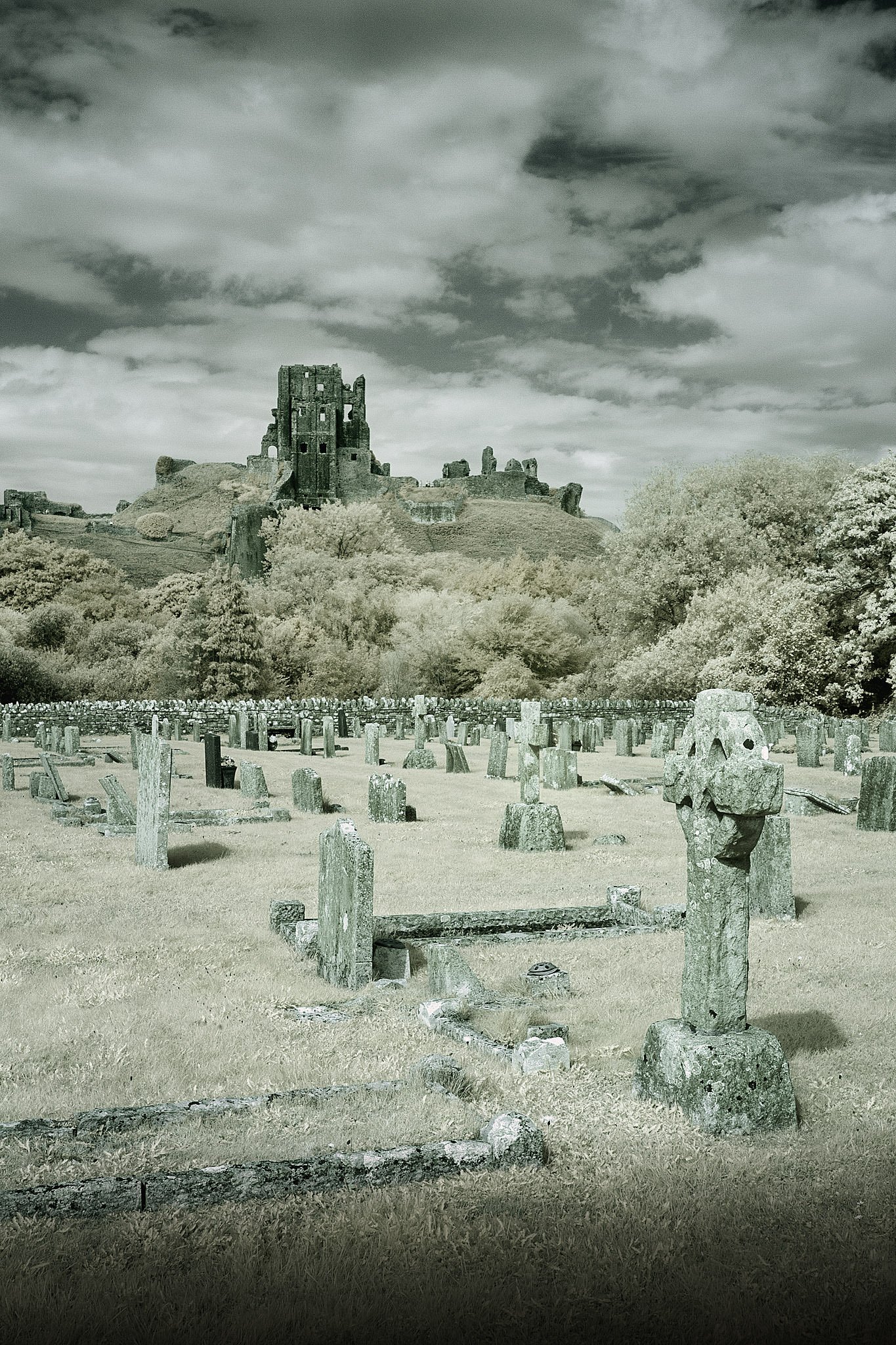Corfe Castle, South West England










The site of Corfe Castle contains evidence of Roman remains, the area also contains Bronze age burial mounds and Iron Age field boundaries. The history of buildings at Corfe Castle dates back to when the Saxon King Edgar died in 975 leaving two surviving sons, Edward, who was a teenager at the time, and Aethelred, his younger half-brother. Edward became the next King, but the succession was disputed. His step-mother, Aelfthryth, was staying with her son in a building which is thought to sit on the location of the current Corfe Castle, where she is said to have plotted against the king. When Edward visited his stepmother three years later at Corfe, he was ambushed and assassinated by her servants. His body was eventually taken to Shaftesbury Abbey, where he was renamed Edward the Martyr and tales of miracles began to spread. Meanwhile his step-brother took the throne and was known as Aethelred the Unready.
After William the Conquerors arrival in England, he began to build castles along the south coast. These early motte and bailey castles were usually wooden structures which were later replaced by stone. At Corfe no motte was necessary, as the landscape itself forms a natural mound, and is one of the best natural defensive sites in England. When William the Conqueror died, he left three sons, Robert, William Rufus and Henry. Robert was given Normandy to rule, and William Rufus became King William II of England. While that might sound amicable, it was not, they both wanted to also have the others lands. While Robert was away on the first crusade, having mortgaged his Duchy to do so, William II died in a hunting accident on the 2nd of August 1100. Their younger brother Henry had himself crowned King of England, just three days after his brother’s death.
King Henry I is often overlooked when we think of medieval Kings, but we may be wrong in doing so. He may have genuinely wanted to be a good King. One of his first acts as King, was to have his Coronation Charter read in every shire in England. In it he promises to be a good Lord, limiting the powers he had over the people, especially in the matters of marriage and inheritance, and contributions which he would levy from them. While it could be read as a list of concessions, it was equally written in a commanding tone, ‘I retain the forests as my father did before me.’ It can also be read as a list of areas over which the King claimed authority. His second act as King had equal brilliance, he married Matilda of Scots. She was the daughter of the King Malcolm III and Margaret, the granddaughter of Edmund Ironside, King of England, and a descendant of King Alfred and the old royal line, which would lend further legitimacy to his Kingship and gain the love of his people.
Soon after Robert II of Normandy returned from crusade, he complained to the Pope that Henry had seized the kingdom in his absence. Henry sent out a second letter to all the shires in the land, which confirmed the laws, rights, and customs that he had granted to them when he first took the crown, and in return reminded them that ‘they will defend his realm against all men and especially against Robert of Normandy, my brother’. Robert landed at Portsmouth on the 20th of July 1101, and Henry’s army was ready to meet them, but instead of the expected battle the brothers came to an agreement, where Robert renounced his claim to England for Henrys lifetime and that of any heir born to him, and in return Henry offered Robert money, 3,000 marks of silver a year.
King Henry I did not stop there however, he also wanted to control his brothers territory in Normandy, which he felt he ruled poorly. Henry conducted a siege outside William of Mortain’s castle at Tinchebrai in 1106, which turned into the battle for Normandy itself when his brother, Robert II of Normandy, came to assist William of Mortain. The battle of Tinchebrai lasted only an hour, and Robert was captured. Henry would now take control of Normandy. It was early in the reign of Henry I that the massive stone keep at the heart of Corfe Castle was constructed. The keep was 80 feet tall and could be seen for miles around. It may not have been built with the intention of housing his brother Robert, but that is exactly what occurred. As soon as Henry I had secured Normandy, Robert was sent to Corfe where he stayed for a year, before being moved, first to Devises, and then to Cardiff Castle. He died in his late 70’s or early 80’s, on the 10th of February 1134.
In 1184, Constance of Brittany gave birth to a daughter named Eleanora. She was presumably named after her grandmother Eleanor of Aquitaine, perhaps a message of support from one imprisoned woman to another. At the time of Eleanora’s birth, Eleanor of Aquitaine was still a captive of her husband Henry II, King of England, the same man who had captured Constance of Brittany’s father, and forced him to abdicate in favour of his 5-year-old daughter Constance, who had been in affect become a prisoner of Henry II ever since. King Henry II then had Constance married to his son Geoffrey when she became 21 years of age, making his third surviving son Geoffrey Duke of Brittany, and thus cementing the overlordship of the Plantagenets over Brittany.
King Henry II’s son, Geoffrey II Duke of Brittany, died on the 19th of August 1186, after being fatally wounded in a tournament in Paris, where he may have been trampled to death after a fall. His half-sister, Marie of Champagne, the daughter of Eleanor of Aquitaine and her first husband King Louis VII of France, attended his funeral and endowed a memorial service for ‘my brother’, so they seem to have been well known to each other. Geoffrey’s wife, Constance of Brittany, at this time was pregnant and Geoffrey’s only surviving son, Arthur, would be born a few months after his death. The birth of Arthur of Brittany meant hope for the Bretons, that one day Brittany would establish its independence from Plantagenet rule. This young boy however ended up being used as a pawn between England and France.
After the death of Geoffrey, Constance of Brittany was forced to marry again, and the 18-year-old Duke of Chester was chosen for her. Sometime after, she was taken off to live with her new husband, and her three children did not go with her. Matilde died shortly after the marriage, and Eleanora joined the household of her grandmother, Eleanor of Aquitaine around 1188. Eleanora was still with her grandmother in 1190, and travelled with her to France to a meeting of Richard I and Philip of France, who were discussing going on crusade. Eleanora would have been about 5 years old at this time. We know that her mother Constance, while trying to leave her husband the Earl of Chester, was captured by him in 1196 while en route to the court of King Richard. The Bretons, fearing treachery, then refused to send Arthur of Brittany to King Richard, and instead appealed for help to the king of France, who was always happy to get involved in Plantagenet disputes. Constance finally managed to return to Brittany in 1198, and succeeded in having her marriage annulled. Eleanora of Brittany had become a ward of King Richard I, although she was kept in her grandmother’s household. We don’t know exactly when Eleanora returned to Brittany.
In August of 1202, Eleanora was at the siege of Mirebeau, about 20 miles north of Poitiers. This is on the route between Fontevraud and Poitiers, where Eleanor of Aquitaine found herself trapped by her grandson Arthur of Brittany’s army in 1202. Queen Eleanor managed to get a letter to her son, King John, at LeMans, and in what may have been John’s greatest military achievement, he crossed the 80 miles to Mirebeau in just 2 days, surprising the attackers and capturing nearly 200 men, including Arthur now aged around 15, and Eleanora, the maid of Brittany now 18 years of age. Arthur was imprisoned at the castle in Falaise, and then in Rouen. By Easter of the following year, he had mysteriously disappeared. Accounts of Arthurs death vary and we don’t have any real knowledge of what happened to him, but blame usually falls to King John.
On the 30th of January 1203, while King John was fighting uprisings on his lands on the continent, he gave orders to 18 English castles which were holding prisoners from the continent, that they be transferred to Corfe Castle. Twenty-two named prisoners were moved, all of whom had fought against John in the Breton uprising. He then wrote to the constable of Corfe Castle, that he should do what Thomas, clerk of our chamber and Hugh de Neville will tell him on the King’s behalf, concerning the prisoners that have been delivered to him. Their fates, while not put into writing by John, were revealed in the annals of Margam Abbey, ‘twenty-two of the noblest and strongest in arms were starved to death in Corfe Castle so that not one of them escaped.’ Even in the early 13th Century, this was not how things were supposed to work. It was customary to ransom your prisoners, not starve them to death.
In the matter of the right to the succession in England, Arthur, having been descended from the third son he would have come before the fourth son, John. In late 12th Century England however, the matter of succession was not as clear. If Henry II’s third son Geoffrey had lived, he would have inherited the throne before John, but as yet the strict rules of primogeniture were not established. Arthur was only 12 years old at the time of the death of King Richard. King Richard I had, in 1190, named his nephew, Arthur, as his heir, he then apparently retracted this and named his brother, John, which didn’t help the succession either. It also didn’t help that England wanted John to be the next King. Arthur was seen as another foreigner and would not have been accepted, on the continent however it was the reverse. They wanted Arthur to rule, and the King of France recognised him as the successor to all of Henry II’s domains. The succession was left uncertain, and it was never going to have a peaceful outcome.
Arthur’s death, or disappearance, left his sister Eleanora as the one person who had as good or better claim to the throne than King John, and so, charged with no crime, and convicted of no offence other than the blood which ran through her veins, she was held in comfortable captivity for the rest of her days. In many respects, the confinement of Eleanor was relatively comfortable, and some have called it an ‘honourable captivity’. Royal records, from Henry III’s reign, show the occasional gifts to Eleanor of cloth, fruit, nuts and wine. She had servants and medical assistance, and at least during the time when Henry III was King, she had her own household. From 1225, she even had an allowance for almsgiving. Lest we might begin to think that she accepted her captivity, and was even happy in it, a few sentences from Eleanora herself survive to shed light on this, from her letter dated the 27th of May 1208, addressed to a small party of Bishops and magnates regarding the prospect of negotiating with King John on her behalf, she wrote:
‘I ask you most solicitously that you, the above named, would travel to England, to my lord uncle, the King of England, knowing for certain that your coming, God willing, will confer great honour and benefit to ourselves and yourselves and, by the grace of God, our Liberation.'
Eleanora of Brittany seems to have been cut off from her family in Brittany, however we do not know to what extent. She seems to have been treated better under King Richard I, where she spent some time at the court, but this was before she was dangerously close to the throne. Under King John however, and in the early years of Henry III, she was housed with Isabelle of Angouleme, and Margaret and Isabel of Scotland, who were given as surety for the King of Scotland, and kept in comfortable captivity. In her later years, visits to her were controlled and her guards were changed regularly. We can see by the treatment of other noble women in confinement, that there were some recognised standards of treatment, that while they were cared for, isolation was its own punishment, and they were often deliberately separated from family members. King Henry II, Richard I, King John and Henry III, do not seem to have made use of convents for confinement, in the same way the Edward I and Edward II did later. Eleanora was kept in custody in England, until her death in 1241. She only left England once, to be at King John’s side when he travelled to Europe. She was held primarily at Corfe, Gloucester, Marlborough and Bristol Castles, of which only Corfe survives.
Having previously sent men to starve to death in the prisons of Corfe Castle, King John thought this would be a good location to build himself a comfortable residence. Corfe Castle was after all impregnable, and situated in excellent hunting grounds. He built himself a Gloriette in the inner ward of the castle, which became one of his favourite residences. The Gloriette was a small luxurious palace, with highly decorated state rooms, a great chamber, and further bedrooms, all above a vaulted stone undercroft. Small amounts of paint work have survived, which tell us that black and white chequered paintwork was interspersed with red as decoration.
King John also reinforced the outer curtain wall. He employed a small army of miners and quarrymen to dig a great ditch, which replaced the wooden defences which separated the keep from the outer bailey. He also enlarged the ditch outside the outer gate in 1214. John also ordered a mangonel, or petrary, for hurling stones outwards from within the castle, and a trebuchet. His last visit to Corfe Castle was in 1215-1216, while he was in the middle of arguing with his Barons over his repudiation of the Magna Carta.
After King John’s death, it was left to his heir, Henry III, to continue the work on Corfe Castle, and it was he who saw the last of the wooden defences at Corfe replaced with stone. He also completed repairs to the old Kings Keep, which included new floors and joists. It was Henry III who ordered that the stone walls of the keep be plastered and limewashed. He also strengthened the entrance to the west bailey, by creating a double towered gatehouse with wooden fighting platform. Finally, he built three new towers into the curtain wall. The last of the work was done by his son, Edward I, who changed the roof of the keep into a flat roof, and updated the Gloriette built by his grandfather, King John.
During the 13th and 14th Centuries, the village of Corfe grew in size as people began to build their homes near the castle. Full time employment could be had at the nearby stone quarries in the Purbeck hills. The town would also require blacksmiths, workmen, craftsmen, grooms, farriers and shopkeepers. Corfe was also granted a market and a fair in the 13th Century. King Henry III’s accounts show that some of the building materials brought to the castle, comprised 759 oak logs, 800 boards, 50 tons of lead, 27,000 nails, as well as stone and other materials. The day to day running of the castle would have fallen to the Constable. He would have been responsible for everything, including administering the garrison, the armoury, provisioning the kitchen, any prisoners, hiring and firing of staff, and preparing the castle for royal visits, all while keeping meticulous records.
Throughout the Middle Ages, Corfe Castle was always a Royal castle, until 1572, when Queen Elizabeth sold Corfe to Sir Christopher Hatton, then a gentleman of the privy chamber. The castle next passed to his niece, the Lady Elizabeth, who made extensive internal improvements and created elaborate greens within the castle grounds.
As a medieval castle, Corfe was always held ready to defend itself, but it never needed to until the 1640’s and the English Civil War. 1635 it was purchased by John and Mary Bankes. John was an up-and-coming lawyer, who became Chief Justice to the king. They were Royalists, who together had 10 surviving children. When war broke out in 1643, John was ordered to serve the King in London. The older boys were sent abroad, while Mary was left behind at Corfe Castle with the younger children, the servants, and a force of 5 men. In 1643, John was declared a traitor by Parliament, and his estates were ordered to be confiscated. On the 1st of May 1643, the first attempt was made to take the castle, but Mary held out. When the Parliamentarian’s demanded that she hand over all firearms or they would burn the village, she complied, under the stipulation that she be allowed to restock her stores at the same time. On the 23rd of June, hundreds of soldiers arrived at Corfe and the siege began. Corfe was proving impregnable still, but it was gunpowder that would see an end to the castles. The soldiers finally stormed the walls and were repelled, not by the garrison but by Mary, who with her daughters and servants, threw down burning coals and stone from the high walls. Throughout the six-week siege, the parliamentarians lost more than 100 men, and the defenders lost only 2. In the end she was betrayed by one of her own men, who led troops into the castle. The parliamentarians virtually destroyed the castle and made it entirely unliveable.
From the looting of Corfe Castle after its occupation by parliamentarians, we know that the Bankes had it lavishly furnished. The inventory from the furnishings taken away includes fabrics, tapestries, beds, bed linen and hangings, carpets, curtains, cushions, clothes and furniture. There were Turkish and Persian carpets for the tables, and a large suite of red velvet chairs, stools, an embroidered couch, embroidered long cushions, also of red velvet. Other items included ebony cabinets, gilded fixtures, trunks full of fine clothes and linen, diaper and damask sheets and table linen. There was also a trunk with fine children’s bed linen. John died in 1644, but Mary fought on from London to regain her confiscated lands, her property rights were returned and Corfe Castle was Mary’s once more. Upon her death, her son ordered her memorial which reads:
‘she had the honour to have borne with a constancy and courage above her sex a noble proportion of the late calamites, and the happiness to have outlived them.’
It is said that it took the Parliamentarians 6 months to destroy Corfe Castle following the betrayal of the Bankes family by Colonel Pitman, a member of the Royalist garrison. They used gunpowder to blow up the castle walls and then when they ran out of gun powder, they taxed the local population in order to buy more. Once it was destroyed, the villagers took stone from the site to rebuild some of the houses in the town. Even today the castle grounds have giant blocks of masonry which sit where they fell.
Despite the English Civil War, the Bankes family was prosperous and retained their estate at Corfe. Their son, Sir Ralph Bankes, built a new home there and, in 1982, their descendant, another Ralph Bankes, bequeathed his estates to the National Trust. This was the largest bequest ever made to the Trust, and includes several miles of Purbeck coastline, nature reserves and farms, as well as the remains of Corfe Castle.












